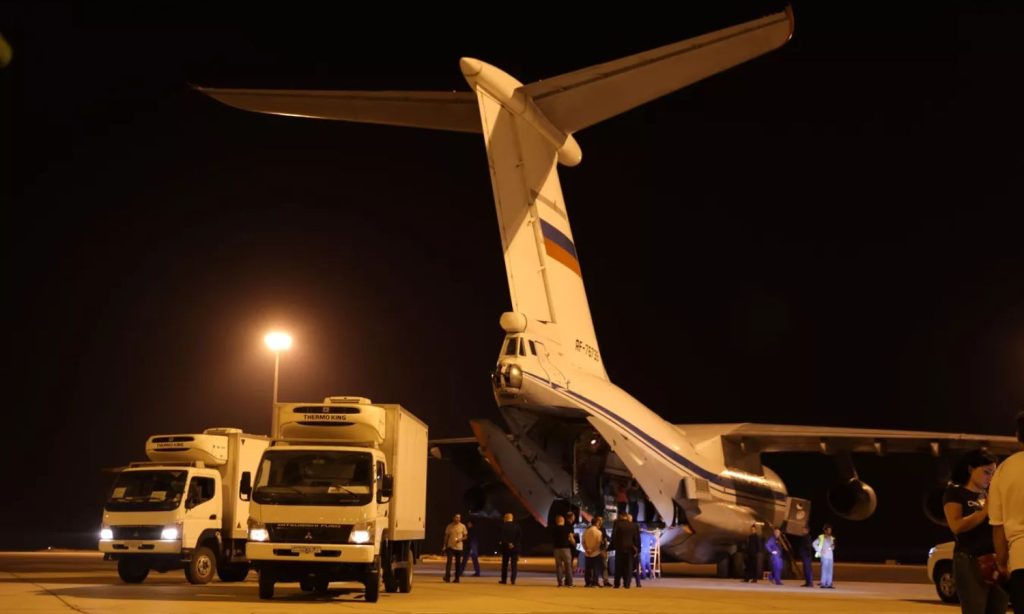Damascus International Airport was subjected to an Israeli air strike at dawn on Monday, causing decommissioning and human and material losses. The Ministry of Transport announced hours later that the airport would return to service, while a local official explained that part of the airport’s runway had been cut off for a rapid return to service.
On Monday evening, January 2nd, the Director-General of the Syrian Civil Aviation Authority, Bassem Mansour, told the al-Mukhtar radio program, which is broadcast on the local Al Khabar television channel and al-Madina FM radio, that the Damascus International Airport returned to service “in record time” after maintenance workshops removed debris from the airstrips and conducted an “engineering displacement” to reduce the threshold of the runway to 500 meters. However, the military runway is disabled.
Mansour indicated that the damage was limited to the airstrips that were the basis of the airport’s services without affecting the airport’s premises. He explained that one of the airstrips was more damaged than the second, that “the engineering displacement of the runway will not affect transportation,” and that the airport is currently fully operational. The second airstrip will soon be back up and running, he stated.
According to Mansour, no flights were delayed after the Israeli raid, with the exception of a flight coming from Moscow that was diverted to the Latakia International Airport.
The Israeli Alma Center for Research and Education revealed the details of the Israeli strike on Monday, saying that “the northern civilian runway was damaged at the front end. To reopen it, officials shortened the runway by 500 meters to continue regular operations”.
Damascus International Airport’s two runways are 3000 meters long and 3600 meters long.
The center indicated that the southern military runway is disabled and that it is possible that targets were also attacked near the al-Ghuzlaniya airport area.
What are the hazards of the cut-off?
Aeronautics researcher and consultant Fares al-Jawari told Enab Baladi that cutting off 500 meters from the runway will affect the take-off and landing of a certain number of large aircraft, such as the Airbus A380 or Boeing 747, according to a specific table established by the International Civil Aviation Organization (ICAO) for each runway length and successful landing requirements.
While this cut-off will not affect the movement of military aircraft, the 2,500-meter runway is sufficient and suitable for military aircraft to take off and land.
According to a study published by the Harmoon Center for Contemporary Studies published on 27 December, the past three years have seen a “surge” in Iranian dependence on air smuggling routes through Syrian airports. Israel’s strategy for dealing with these security threats is no longer limited to stalking and striking sensitive cargo within the site or storage areas only but rather moved to attack facilities related to logistical transportation operations, navigation systems, aircraft stands, and Syrian airport runways.
The said study revealed that Israeli raids in 2022 targeted more than 25 military targets inside Syrian airports involved in the study (Damascus, T-4 Airbase, Shayrat, Aleppo, Mazzeh, and al-Dabaah), reflecting an increase of 92% compared to 2021, and of about 19% compared to 2020.
Conflict of numbers with Hmeimim
The Russian Reconciliation Center for Syria announced that six elements of the Syrian regime forces were killed in the latest Israeli air strike that targeted Damascus International Airport at dawn on Monday.
Oleg Egorov, deputy head of the Russian Center for Reconciliation for Syria, said during a press briefing reported by the Russian Sputnik News Agency on Tuesday, January 3rd, that “Four Israeli Air Forces (IAF) warplanes had launched air strikes from the Golan Heights without entering Syrian airspace at approximately 2 o’clock in the morning yesterday, Monday”, and that these strikes “had targeted positions in the capital Damascus.”
The raids had killed six Syrian regime soldiers and wounded three others. Meanwhile, a military source announced via the Syrian Arab News Agency (SANA), several hours after the shelling, that two elements had been killed and two others had been injured, that there had been some material losses, and that Damascus International Airport had been decommissioned.
The Israeli strike on Damascus International Airport is the second in seven months to put the airport out of service. On 10 June 2022, Israeli airstrikes targeting the airport caused severe damage to infrastructure and runways until it reopened following two weeks of repairs.
In September 2021, Israeli air strikes targeted the Aleppo International Airport in northern Syria, leaving it out of service for several days.
There was no Israeli comment on the most recent air strike, and it did not claim responsibility for it, as usual, after any targeting. However, it recently said that its strikes in Syria are to disrupt the “Iranian project” created by Qassem Soleimani to establish “Hezbollah 2” in southern Syria.











